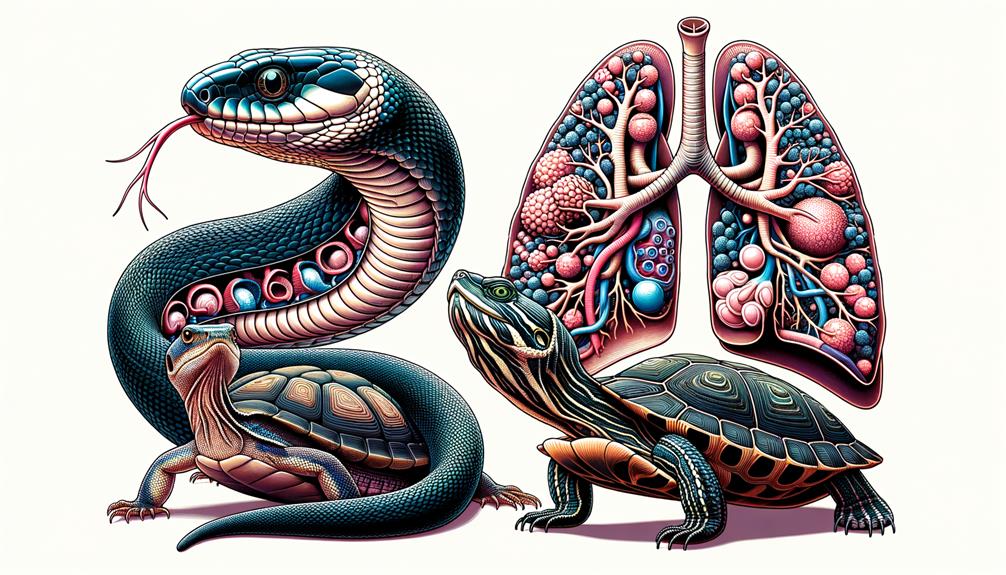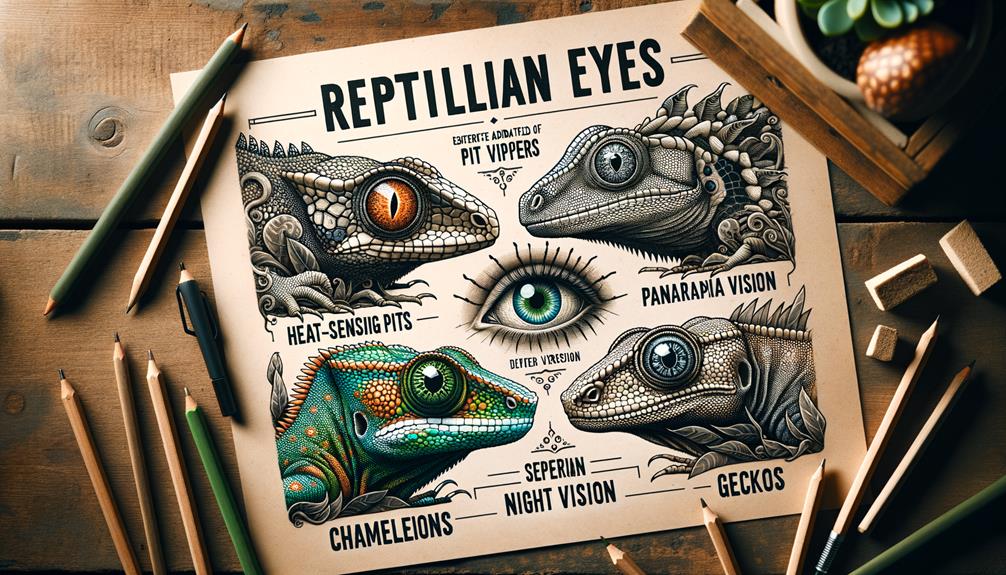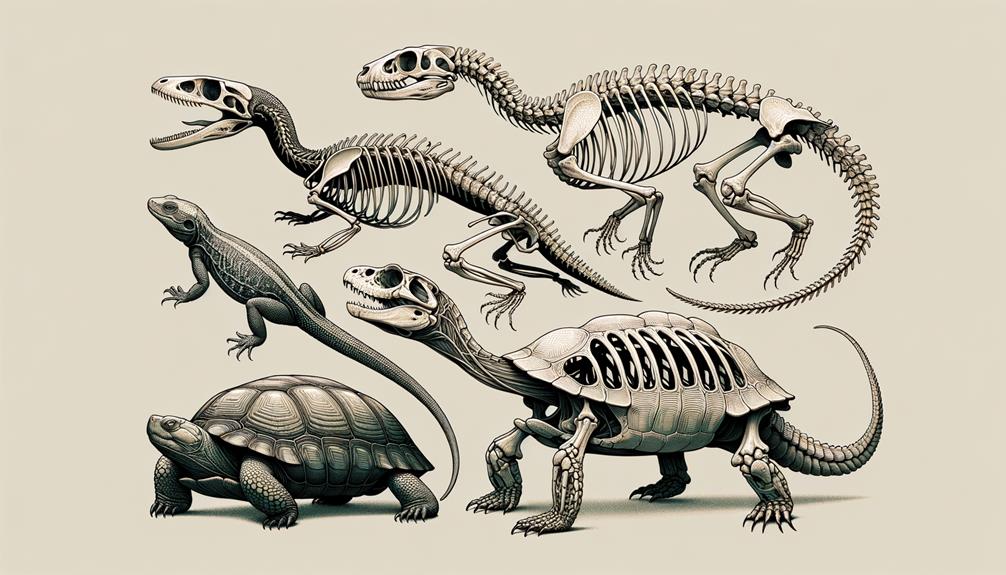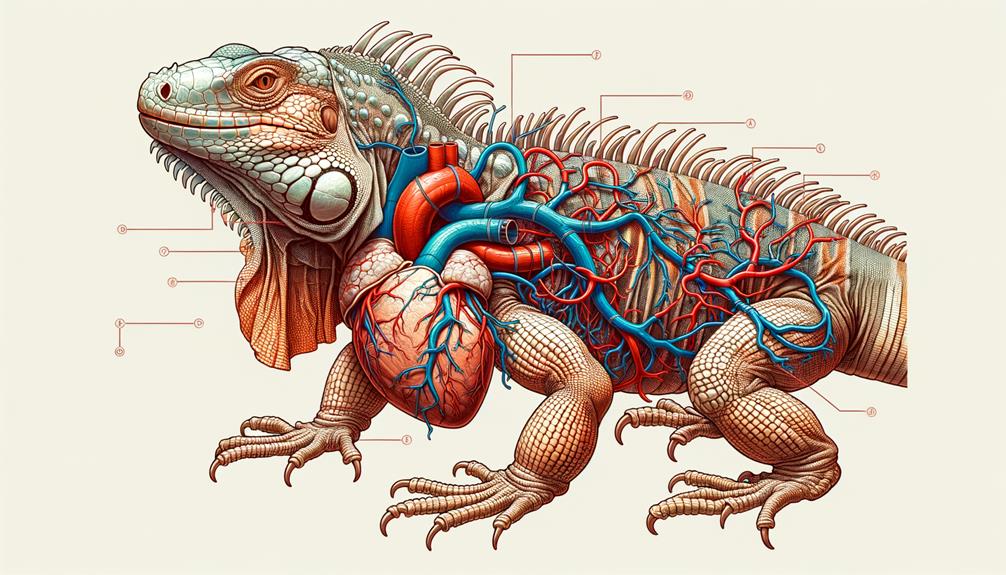Reptilian anatomy is a fascinating story of adaptation. Their scaly skin reduces water loss and provides protection from predators. To regulate their body temperature, they use strategies like basking in the sun and burrowing underground. The unique structure of their lungs and unidirectional airflow allow them to take in oxygen efficiently. From the loss of limbs in snakes to the sticky toe pads in geckos, their methods of movement are highly specialized. Their senses are also finely tuned, with excellent eyesight, a keen sense of smell using Jacobson's organ, and heat-sensing pit organs that help them hunt and survive. When it comes to reproduction, reptiles have evolved remarkable strategies, including laying eggs with amniotic membranes and determining sex based on temperature, which ensures the continuation of their species in diverse habitats. There's still much to learn about these incredible creatures and their remarkable adaptations.
Key Takeaways
Reptiles have evolved various adaptations to survive and thrive in their environments.
Keratinous scales serve as protective armor, reduce water loss, and aid in camouflage and social signaling.
To regulate their body temperature, reptiles employ diurnal basking, nocturnal heat exchange, and burrowing.
Respiratory adaptations, such as divided lungs, muscular breathing in turtles, and unidirectional airflow in crocodilians, maximize oxygen intake.
Limb variations have also evolved to enhance locomotion, like limb reduction in snakes and specialized limbs in marine reptiles and geckos.
Sensory adaptations, including forked tongues, Jacobson's organ, and heat-sensing pit organs, improve prey detection and environmental perception.
Scale Structure and Function
When we take a closer look at the intricate design of reptilian scales, it's clear they serve both protective and physiological functions that are vital for survival. Each scale is made of keratin, the same protein found in human hair and nails, providing a tough, resilient armor. This structure shields reptiles from physical injuries and predators, while also minimizing water loss – a critical adaptation for life on land.
Fossil records show that scales have been around for millions of years, giving us a glimpse into their evolutionary journey. Early reptiles already had scale structures, suggesting these features were beneficial for their survival and proliferation. By studying fossilized scales, we can see how different species adapted their scale patterns and structures to meet specific environmental challenges.
Scales are more than just a protective barrier; they play a crucial role in locomotion, reducing friction as reptiles slither or crawl. Additionally, scales can house specialized cells called chromatophores, which allow for color change, aiding in camouflage or social signaling. Each of these functions highlights how scales are closely tied to the freedom and adaptability of reptiles, enabling them to thrive in diverse habitats.
Thermoregulation Strategies

Reptiles have developed remarkable thermoregulation strategies to maintain ideal body temperatures in varying environments. Their thin skin and lack of internal heat production require a range of behavioral and physiological mechanisms. Diurnal lizards, for instance, bask in the sun to absorb heat and elevate their body temperatures, while nocturnal reptiles rely on passive heat exchange to stay warm.
In desert environments, some reptiles, like the desert iguana, have adapted to extreme temperatures, with body temperatures ranging from 100 to 108°F. Their body plans are adapted for these conditions, allowing them to thrive in environments where others might struggle. To conserve energy and water, desert reptiles often retreat into burrows during the hottest parts of the day, reducing their need for active thermoregulation.
Certain reptiles have evolved specialized adaptations to regulate heat absorption. The chuckwalla, for example, can inflate its body to increase its surface area and better control heat intake. These strategies showcase the evolutionary ingenuity in reptilian thermoregulation, enabling them to survive and flourish in diverse habitats. By mastering these techniques, reptiles demonstrate their ability to adapt and thrive in environments that demand resilience and flexibility.
Respiratory System Adaptations

Over millions of years, reptiles have developed remarkable respiratory adaptations to thrive in diverse environments. A striking feature of these adaptations is the division of their lungs into anterior and posterior sections, evident in reptile groups like lizards and snakes. This unique anatomy enables them to maximize oxygen intake, which is crucial for their survival in various habitats.
In turtles, the respiratory system is even more fascinating. Their rigid shells require a distinct breathing mechanism. Instead of relying on ribcage expansion, turtles use muscular contractions to force air in and out of their lungs. This adaptation allows them to excel in both terrestrial and aquatic environments. Crocodilians, another notable group, possess a unidirectional airflow system similar to birds. This system optimizes oxygen extraction, ensuring these reptiles remain agile and powerful, whether in water or on land.
Locomotion and Limb Variations

In exploring reptilian locomotion and limb variations, I find it fascinating how snakes have adapted to navigate diverse environments by reducing their limbs. The unique movement adaptations of marine reptiles, with their flipper-like limbs, and geckos, with their adhesive toe pads, demonstrate the remarkable flexibility of reptilian anatomy. These adaptations not only improve survival rates but also enable reptiles to thrive in a wide range of ecological niches.
Limb Reduction Mechanisms
Examining the mechanisms behind limb reduction in reptiles reveals fascinating evolutionary adaptations that enhance their locomotion in diverse environments. Snakes and other limbless reptiles have developed strategies to shorten, simplify, or completely lose their forelimbs and hindlimbs. For example, mass extinction events in Earth's evolutionary history have driven these reptiles to adapt to constrained habitats like burrows or aquatic environments, where limbs may become a hindrance rather than an advantage.
Certain lizard species, such as skinks and glass lizards, exhibit partial limb reduction. These reptiles retain small, non-functional limbs or digits that signify an evolutionary progression. Genetic studies have identified key regulatory changes during embryonic development that lead to gradual limb reduction or complete limb loss, showcasing the intricate relationship between genetics and environmental pressures.
Here's a visual representation of these mechanisms:
| Reptile Type | Limb Reduction Mechanism | Locomotion Adaptation |
|---|---|---|
| Snakes | Complete limb loss | Efficient lateral undulation |
| Skinks | Vestigial limbs | Improved burrowing |
| Glass Lizards | Partial limb reduction | Enhanced mobility in narrow spaces |
| Aquatic Reptiles | Limb simplification | Effective swimming |
These adaptations often result in elongated, serpentine body shapes, allowing these reptiles to navigate through narrow spaces or move efficiently on land.
Specialized Movement Adaptations
Reptiles have evolved remarkable movement adaptations to thrive in their environments. Snakes and legless lizards, for instance, have developed serpentine movements and burrowing adaptations that enable them to navigate sandy desert substrates efficiently. Their counter-sunk lower jaws facilitate movement on and within the sand, reducing energy expenditure and increasing their chances of survival.
The fringed toes of fringe-toed lizards provide increased traction and stability, allowing them to traverse loose desert dunes with ease. Similarly, sidewinders and other desert-dwelling reptiles have developed lateral undulating gaits that minimize surface contact, reducing heat absorption from the scorching sand. This unique locomotion not only conserves energy but also shields them from extreme temperatures.
Gila monsters have evolved fatty tails that store water, which they use for evaporative cooling, a vital thermoregulatory adaptation. Chuckwallas can modulate heat absorption or dissipation by inflating their bodies. These specialized movement adaptations demonstrate how reptiles have evolved to survive and flourish in their diverse environments.
Sensory Organs and Perception

When I examine the sensory adaptations in reptiles, I'm struck by their impressive visual capabilities. Many species have color vision and can judge distances with ease. Snakes and some lizards take it a step further with heat-sensing pit organs, which allow them to detect prey by sensing infrared radiation. Their chemoreception abilities, including the vomeronasal organ, also enable them to pick up on a wide range of chemical cues in their environment.
Enhanced Vision Capabilities
Reptiles have evolved an impressive range of visual adaptations, including the ability to perceive ultraviolet and polarized light, which significantly enhances their interaction with their environment. As amphibians and reptiles diverged millions of years ago, these creatures developed unique visual capabilities to thrive in their respective habitats. For instance, reptilian eyes often feature vertical slit-shaped pupils, which adjust more effectively to varying light levels, aiding both diurnal and nocturnal activity.
Reptiles possess specialized retinal structures that allow for remarkable color discrimination and high visual acuity. Their photoreceptor cells are fine-tuned to detect a wide range of light intensities, ensuring they can hunt or evade predators under different conditions. Some lizards and snakes even have a parietal 'third eye' that can detect changes in light and temperature, providing additional environmental awareness.
Reptilian vision often outperforms that of mammals in terms of temporal and spatial resolution. This superior visual system enables them to detect prey and avoid predators with exceptional precision. These evolutionary advancements illustrate how reptiles have honed their senses to maintain an edge in their ecological niches. By developing these adaptations, reptiles have optimized their survival strategies in their environment.
Chemoreception and Tongue Flicking
While reptiles' vision is remarkable, their sense of chemoreception is equally impressive, largely due to their unique tongue-flicking behavior. This adaptation dates back to their common ancestor, giving them a significant edge over their amphibious predecessors.
Snakes and lizards, for instance, have forked tongues that play a crucial role in detecting chemical cues in their environment. When they flick their tongues, they collect particles from the air and ground, which are then transferred to the Jacobson's organ, an advanced sensory organ located in the roof of their mouths. This organ is highly sensitive to pheromones and other chemical stimuli.
Reptiles' chemoreceptors are exceptionally skilled at picking up signals that indicate the presence of prey, predators, or potential mates, often from impressive distances. This ability is vital for their survival and reproduction, allowing them to navigate their habitats with precision.
The development of the Jacobson's organ and tongue-flicking behavior marks a significant adaptation that distinguishes reptiles from both their amphibious ancestors and mammals, highlighting the unique evolutionary path that mammals and reptiles have followed since their divergence from a common ancestor.
Heat-Sensing Pit Organs
Heat-Sensing Pit Organs
Among the most fascinating features found in reptiles are the heat-sensing pit organs in certain snakes, which enable them to detect infrared radiation with remarkable precision. These specialized organs, present in families like Viperidae, Crotalidae, and Boidae, are remarkable examples of evolutionary adaptation. Located in depressions on the snake's head, these pit organs contain a membrane-bound cavity filled with fluid, which is innervated by the trigeminal nerve, creating a direct pathway for sensory information.
The infrared receptors in these pit organs are incredibly sensitive, detecting temperature differences as small as 0.001°C. This remarkable sensitivity allows snakes like pit vipers to locate warm-blooded prey even in complete darkness. For instance, a rattlesnake can strike a mouse hidden behind an obstacle or perfectly camouflaged, thanks to its heat-sensing ability.
This adaptation has significantly contributed to the evolutionary success and diversification of venomous snakes across the Americas and Eurasia. By using infrared detection, these snakes have refined their hunting strategies, ensuring their survival and proliferation in various environments. Fundamentally, heat-sensing pit organs exemplify nature's ingenuity in enhancing sensory perception.
Reproductive Mechanisms

The development of amniotic eggs, complete with specialized membranes such as the amnion, chorion, and allantois, was a game-changer for reptilian reproduction. These eggs, with their protective and nourishing features, allowed reptiles to thrive in terrestrial habitats, independent of aquatic environments. The amniotic egg's structure provides a self-contained aquatic environment, ensuring embryo survival without the need for water bodies.
Some reptiles have taken reproductive adaptability to the next level with viviparity – bearing live young instead of laying eggs. This adaptation is particularly useful in harsh or arid environments, where egg desiccation could be a threat. Viviparity allows for greater parental protection and mobility, enhancing offspring survival.
Reptilian reproductive mechanisms showcase incredible evolutionary ingenuity:
| Adaptation | Emotional Impact |
|---|---|
| Amniotic eggs | Freedom from aquatic constraints |
| Internal fertilization | Enhanced reproductive success |
| Viviparity | Protection in harsh environments |
| Temperature-dependent sex determination | Fascination with nature's control |
| Parthenogenesis | Wonder at asexual reproduction |
These diverse reproductive strategies have secured reptiles' place in a multitude of ecosystems, symbolizing resilience and the relentless quest for survival.
Frequently Asked Questions
What Are the Evolutionary Adaptations of Reptiles?
Reptiles have developed remarkable adaptations that enable them to thrive on land. Their waterproof skin and unique egg membranes are just a couple of examples. They regulate their body temperature by basking in the sun and have evolved specialized features to survive in harsh desert environments, such as storing water and managing waste.
What Are Five Adaptations of Reptiles?
Reptiles have developed five key adaptations that enable them to thrive in diverse, often harsh, environments. These traits include waterproof skin that prevents water loss, specialized egg membranes that allow embryos to breathe, thermoregulatory mechanisms that help them control their body temperature, unique locomotion methods such as crawling or slithering, and advanced water management systems that conserve water.
What Are the Evolutionary Characteristics of the Class Reptilia?
Reptiles first appeared over 300 million years ago, and they developed some remarkable traits to thrive on land. Their scaly skin helped prevent water loss, while their amniotic eggs allowed them to reproduce on land. Additionally, they adapted their respiratory and circulatory systems to be more efficient and better suited for survival.
What Features Have Reptiles Developed to Adapt to Environmental Changes?
Reptiles have developed several remarkable adaptations to cope with environmental changes. For instance, they've evolved waterproof skin, protective egg membranes, and specialized respiratory systems. Some reptiles have also developed burrowing capabilities and nocturnal habits, allowing them to thrive in diverse and often extreme conditions.



